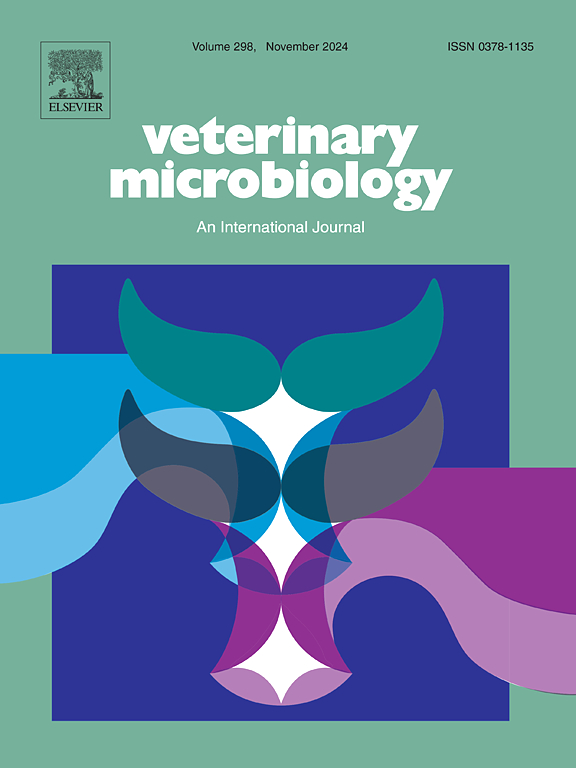IFN-β contributes to astrocyte activation in the brain following coronavirus PHEV infection independent on peripheral immunity
IF 2.4
2区 农林科学
Q3 MICROBIOLOGY
引用次数: 0
Abstract
Porcine hemagglutinating encephalomyelitis (PHE), caused by a betacoronavirus named porcine hemagglutinating encephalomyelitis virus (PHEV), is a highly fatal disease of pigs characterized by nonsuppurative encephalitis. Activation of astrocytes is a hallmark of viral encephalomyelitis; however, the mechanism of PHEV-induced astrocyte activation is currently unknown. Based on mouse model, we show that PHEV infection led to astrogliosis in mouse brain and brain slice cultures (BSCs), as indicated by increased expression of glial fibrillary acidic protein (GFAP). PHEV can neither infect nor activate primary astrocytes in vitro, indicating that activation of astrocytes maybe mediated by factors secreted from viral infected neurons but not by direct viral infection of astrocytes. PHEV infection results in increased interferon (IFN) response in later stage, we thereafter focused on whether IFN-β can activate astrocytes after PHEV infection similar to other neurotropic viruses. IFN-β treatment resulted in both the upregulation of GFAP and activation-associated cytokines/chemokines in mouse primary astrocytes. Furthermore, the addition of IFN-β neutralization antibody prevented PHEV-infected mouse brain tissue homogenate from activating astrocytes. Taken together, IFN-β triggers the activation of astrocytes in the central nervous system (CNS) following PHEV infection. Further understanding of the role of activated astrocytes during PHEV infection may provide new insights for treatment this disease.
IFN-β有助于冠状病毒 PHEV 感染后大脑星形胶质细胞的活化,与外周免疫无关。
猪血凝性脑脊髓炎(PHE)是由一种名为猪血凝性脑脊髓炎病毒(PHEV)的betacoronavirus引起的,是一种高度致命的猪疾病,以非化脓性脑炎为特征。星形胶质细胞活化是病毒性脑脊髓炎的特征之一;然而,PHEV 诱导星形胶质细胞活化的机制目前尚不清楚。基于小鼠模型,我们发现 PHEV 感染会导致小鼠大脑和脑片培养物(BSCs)中的星形胶质细胞增生,表现为胶质纤维酸性蛋白(GFAP)的表达增加。PHEV 既不能感染也不能激活体外原发性星形胶质细胞,这表明星形胶质细胞的激活可能是由病毒感染的神经元分泌的因子介导的,而不是由病毒直接感染星形胶质细胞介导的。PHEV 感染后期会导致干扰素(IFN)反应增强,因此我们关注 PHEV 感染后 IFN-β 是否能像其他神经毒性病毒一样激活星形胶质细胞。IFN-β 处理可导致小鼠原代星形胶质细胞的 GFAP 和活化相关细胞因子/趋化因子上调。此外,添加 IFN-β 中和抗体可防止 PHEV 感染的小鼠脑组织匀浆激活星形胶质细胞。综上所述,PHEV 感染后,IFN-β 会引发中枢神经系统(CNS)中星形胶质细胞的活化。进一步了解 PHEV 感染期间活化星形胶质细胞的作用可能会为治疗这种疾病提供新的见解。
本文章由计算机程序翻译,如有差异,请以英文原文为准。
求助全文
约1分钟内获得全文
求助全文
来源期刊

Veterinary microbiology
农林科学-兽医学
CiteScore
5.90
自引率
6.10%
发文量
221
审稿时长
52 days
期刊介绍:
Veterinary Microbiology is concerned with microbial (bacterial, fungal, viral) diseases of domesticated vertebrate animals (livestock, companion animals, fur-bearing animals, game, poultry, fish) that supply food, other useful products or companionship. In addition, Microbial diseases of wild animals living in captivity, or as members of the feral fauna will also be considered if the infections are of interest because of their interrelation with humans (zoonoses) and/or domestic animals. Studies of antimicrobial resistance are also included, provided that the results represent a substantial advance in knowledge. Authors are strongly encouraged to read - prior to submission - the Editorials (''Scope or cope'' and ''Scope or cope II'') published previously in the journal. The Editors reserve the right to suggest submission to another journal for those papers which they feel would be more appropriate for consideration by that journal.
Original research papers of high quality and novelty on aspects of control, host response, molecular biology, pathogenesis, prevention, and treatment of microbial diseases of animals are published. Papers dealing primarily with immunology, epidemiology, molecular biology and antiviral or microbial agents will only be considered if they demonstrate a clear impact on a disease. Papers focusing solely on diagnostic techniques (such as another PCR protocol or ELISA) will not be published - focus should be on a microorganism and not on a particular technique. Papers only reporting microbial sequences, transcriptomics data, or proteomics data will not be considered unless the results represent a substantial advance in knowledge.
Drug trial papers will be considered if they have general application or significance. Papers on the identification of microorganisms will also be considered, but detailed taxonomic studies do not fall within the scope of the journal. Case reports will not be published, unless they have general application or contain novel aspects. Papers of geographically limited interest, which repeat what had been established elsewhere will not be considered. The readership of the journal is global.
 求助内容:
求助内容: 应助结果提醒方式:
应助结果提醒方式:


